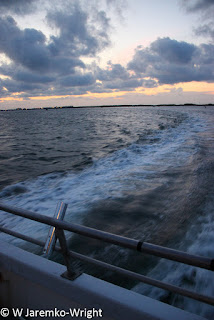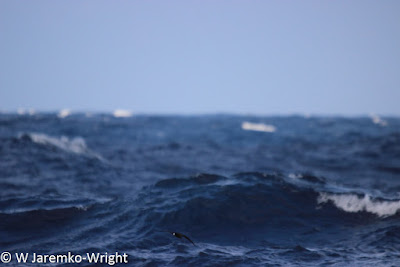Following a great week at the USFWS Friends Academy in West Virginia, I bed farewell to new found friends, picked up a sweet Kia rental car and pointed it's wheels south towards North Carolina. I crossed the bridges and tunnels that cross the James River from Newport News to Norfolk a little after sunset, catching some lasting orange impressions of Virginia. I had a great time on the Outer Banks, and off the Outer Banks with my first time ever birding the open ocean. This experience included 5 new lifer birds, me getting nauseous, my first visit to the open ocean (>2 mi from shoreline), 25 miles off the coastline, off the continental shelf at a depth of 2000+ feet. The birding was incredible on the ocean and on land, as I also got to know two new Wildlife Refuges; Alligator River NWR and Pea Island NWR, as well as two national seashores, and a state park.
I arrived in Haterras, NC at far too late in the evening to care where my bed was going to be. I ended up sleeping at the end of a dock near the Pelagic Trip's boat, the Stormy Petrel II was docked.
This trip was aboard the Stormy Petrel II with lead guide Kate Sutherland. We left around 5:30am into windy conditions for a long round-about trip to get beyond shallow shoals and through the Hatteras inlet, a break in the barrier island connecting the Atlantic with Pamlico Sound.
The trip out of the sound was a fun, easy water trip through classic inland bay habitat. Shorebirds occupying small islands, Great Laridae diversity; Common Tern, Royal Tern, Black Terns, and Caspian terns, in addition to Herring Gulls, Great Black-Backed Gull, and Laughing Gulls coursed overhead. Squadrons of Brown Pelicans patrolled the coastlines.
After approximately an hour beyond the last view of the continent on the eastern horizonwe had made it to at least 10 miles off-shore. Along the way we ran into several small groups of Black Terns and a handful of Phalaropes. At about this distance from shore we began to encounter our first true seabirds of the day. A small black and white bird seemingly appeared out of no where, streamlined against the direction of the boat, wheeled right and was gone. In a total of 2 seconds I had seen a bird that was white below, black above, with a high aspect ratio (long but thin wingspan) appear out of nowhere and disappear again. I had just seen my first true seabird - Audubon's Shearwater! We would end up seeing two more shearwaters this trip, Cory's Shearwater, and Great Shearwater, both much larger than Audubon's. Their quick wheeling flight and use of updrafts from the waves was impressive and characteristic of this family of birds.
After becoming familiar with at the three Shearwaters, a much much smaller bird began appearing out of the blue. Wilson's Storm-petrels, with their fast wheeling flight like a swallow, and the behavior of skimming the surface of the ocean in our wake, were impressive, if dainty seabirds.
The Wilson's Storm Petrels continued to follow our ship (and it's fish oil trail) for the next few hours, with as many as a dozen at their most. Besides the ones following the ship, we'd encounter occasional flybys. Searching for these birds, no bigger than an Inca Dove in the wide open ocean was a thrilling reason to keep an eye out on the horizons.
 |
| Pair of Wilson's Storm-Petrels skirting the waves, they never flew more than 10 feet above the surface, and on a day with 15ft swells this was all the more impressive. |
 |
| Wilson's Storm Petrel |
 |
| Wilson's Storm Petrels spend a lot of time 'touch and going', flitting about on the surface of the water, picking through algae clumps for invertebrate food and all other manner of wee-beasties. |
 |
| The oddly-shaped large fore-head look of Wilson's Storm Petrels is distinctive of all the Storm-petrels. |
After a couple of hours of good, albeit brief looks at shearwaters, we finally got sight of a larger, much more angled-wing flyer - Black-capped Petrels. These were larger than the shearwaters, and much more acrobatic flyers, swooping high, then low into the waves, and up again. They're black-white pattern distinctive, and their flight pattern unlike the shearwaters. As we birded more and more it became apparent how much flight pattern aids in ID of at least the commonly encountered birds in the pelagic zone off North Carolina.
 |
| Black-capped Petrel, with it's namesake black cap, accentuated by the white nape. |
The bird activity was like this, many birds at once, up to 5 species, then nothing for 30 minutes, then another group. The birds of the ocean, like land, are not distributed evenly across the map.
 |
| A couple of Black-capped Petrels mixed in with Wilson's Storm-Petrels in the Gulf Stream, Outer Banks, NC. |
The Black-capped Petrels, which are found throughout the Atlantic Ocean, breed in Cuba and islands of the Dominican Republic. Like other Petrels, they nest in burrows dug into the sides of steep cliffs or rugged hills inaccessible from land-based predators. They are considered threatened under the IUCN due to loss of breeding sites and predation by humans and introduced species. More on Black-capped Petrels here.
 |
| Black-capped Petrel wheeling toward the boat. I loved this black cap-white nape look this bird was sporting! |
 |
| This image of the side of the Black-capped Petrel shows it's famed tube-nose, present in all Procellariiformes (Tubenoses). |
We were not alone out on the ocean, we saw one cargo ship, several miles away but lurking like a gigantic city out on the waves. The size of this boat as seen from afar was truly amazing, and to think about the same type of vessel dealing with these waves that we were cresting and plunging with much action was an interesting notion. Surely this ship must have hardly felt the types of waves we were experiencing.
 |
| Cruising back to shore, this land-loving Llanero was happy to be back to shore! |
We arrived back to the marina in Haterras by 5:30pm after a total of 12 hours out on the water. After a quick bathroom stop I headed out for Cape Haterras National Seashore's Frisco Campground a few miles north and a (I felt) well deserved cold beer.







No comments:
Post a Comment